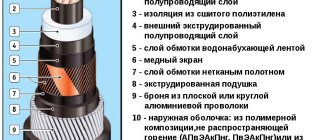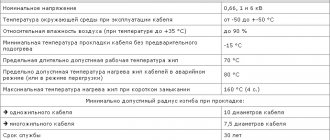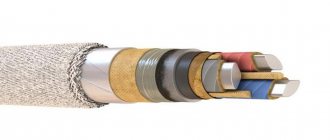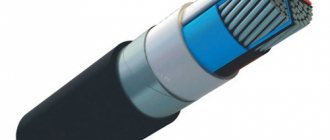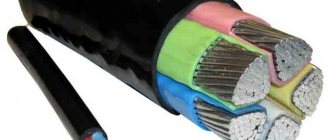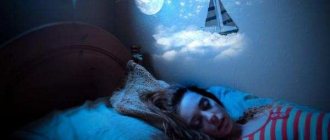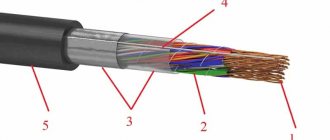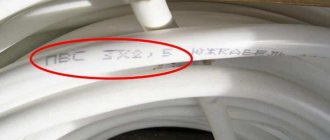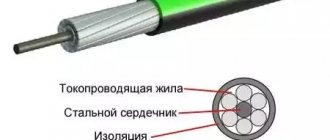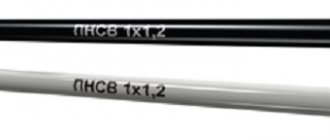KGVV cable design elements:
1. Current-carrying conductor - copper, stranded, round, class 4 or 5 with a nominal cross-section up to 10 mm2 inclusive, conductors with a nominal cross-section of 16 mm2 and above - classes 3, 4 and 5 according to GOST 22483. 2. Insulation - made of polyvinyl chloride plastic compound (PVC ). Insulated cable cores with a number of cores up to 5 inclusive have a distinctive color. The insulation of the neutral conductors is blue. The insulation of the grounding conductors is two-color (green-yellow). In cables with a number of cores of 7 or more, each layer has a counting core and a directional core that differ in color from each other and from the rest of the cores in the layer. 3. Twisting - insulated cable cores are twisted in concentric layers; insulated cores of four- and five-core cables can be twisted around a core insulated with PVC plastic. Three- and four-core cables have all conductors of the same cross-section or one conductor of a smaller cross-section (grounding or neutral conductor). Cables may have a grounding conductor with a nominal cross-section equal to the nominal cross-section of the main conductor. 4. Shell - PVC plastic
Color designation of cores of power cable KG
The outer insulating layer of a single core is painted in the desired color or has a blue stripe along its entire length. Most often, the grounding circuit is made yellow-green, the neutral conductor is blue or cyan (or with the symbol “0”).
When designating the cores of a KG cable, it is prohibited to use three colors - red, white and gray. Other shades are acceptable, but the designation is not important. Depending on the individual preferences of the customer, the cores can be painted in certain colors, have stripes, or be produced without colors.
Depending on the number of cores, the colors may be as follows:
- three veins - yellow-green, blue and brown;
- four – yellow-green, blue, black and brown;
- five – yellow-green, blue, brown and two black;
- six – yellow-green, blue, brown and three black.
Scope of application of the KGVV cable:
For fixed installation of power and control circuits on machines and mechanisms at voltages of 660 and 1000 V AC with a frequency of up to 60 Hz. The cables can be operated at voltages of 1000 and 1500 V DC respectively. For permanent installation with a bend radius of at least five outer diameters of the cable. Cables are not recommended for laying in the ground (trenches). Cables of the KGVV brand do not spread fire when laid alone. In the designation of cables with a zero core, the letter “n” is added to the brand. It is allowed to lay cables in the air, provided that additional measures are taken to protect against exposure to solar radiation.
Options for laying the KG cable
An electrical product can be laid in different ways. Let's list the main ones:
- In pipes, when additional protection from external negative factors and mechanical loads is required when installed in an open area. For these purposes, you can use ceramic, metal and polyvinyl chloride pipes. The installation process is carried out in accordance with the points of the PUE (rules for installation), therefore, at the points of contact of different parts, it is necessary to ensure a tight connection and the absence of gaps. This will prevent any molecules from getting inside the pipe. To get rid of gaps, use special couplings. Install heat-resistant protection (for example, resin tape) at the inlet and outlet. The diameter of the pipe should be two to three times larger than the cable.
- In gutters - a more popular and widespread method, which is actively used when laying products in a chemically aggressive environment (workshops, production facilities). The cross-sectional area of cables placed in gutters should not exceed 16 square meters. mm. The main feature of the installation is that all the wires are placed in one layer at a certain distance. Thus, the width of the gutter is selected depending on the number of wires, and taking into account the interval between each of them.
- Air laying. When choosing this method, you must first take into account all environmental factors that may affect the cable. Do not forget that wind and precipitation can place additional load on both the cable and the supporting structure (overpass, cable). Severe operating conditions may result in connection failure or loss.
- Open gasket. The simplest method, according to which there is no need to use additional materials and structures. Can be used provided there is no threat of breakage or loads. Relevant for facilities with a small number of people and the ability to place the suspension at a sufficient height. It is strictly forbidden to place cables in passages. A very economical method, the implementation of which does not require machinery or special equipment. However, unexpected hazards may arise during the installation process. Requires responsibility and care.
- Laying the KG cable in the ground is unrealistic and undesirable, therefore its protection does not imply such operation. This can lead to damage and breakage due to construction waste, increased soil density, etc.
- On ships they use a modification of the KG-HL cable.
Thus, the standard CG and its modifications make it possible to ensure reliable switching of mobile installations and units. It is important to remember that the electrical product is only suitable for temporary connection, so you should not hide it far. The main disadvantage is the lack of possibility of laying underground. Compared to numerous analogues, the KG cable will be more expensive, but its high cost is compensated by its unsurpassed technical and operational characteristics.
Technical characteristics of the KGVV cable:
— Type of climatic modification of cables UHL, placement category 5 according to GOST 15150-69 — Operating temperature range: from -50°С to +50°С — Relative air humidity at temperatures up to +35°С: up to 98% — Laying and installation of cables without preheating, it is produced at a temperature not lower than: -15°C - Minimum bending radius when laying: 5 outer diameters. — AC frequency: up to 60 Hz — Test AC voltage with a frequency of 50 Hz (test duration 10 min): for a voltage of 0.66 kV — 3 kV for a voltage of 1 kV — 3.5 kV — Long-term permissible heating temperature of cable cores during operation: +70 °C - Construction length not less than: 100 m - Warranty period: 5 years from the date of commissioning of the cables, but no later than 6 months from the date of manufacture - Service life of the KGVV cable - 30 years.
Cable products and metal mesh
Design:1. The conductor is made of soft copper wires, at least class 5 according to GOST 22483.
2. Insulation – made of polyvinyl chloride plastic.
3. Twisting - insulated cable cores are twisted into a core. Insulated cable cores with a number of cores up to 5 inclusive have a distinctive color. Each layer of cables with a number of cores of 7 or more must have a counting core and a directional core that are different from each other and from the rest of the cores of the layer.
4. Screen (for brands KGVEV and KGVEVng(A) ) - made of copper wires, made in the form of a braid.
5. Sheath – for brands KGVEV, KGVV, KGVVz from PVC plastic compound, in cables of brands KGVVng(A), KGVEVng(A), KGVVzng(A) from PVC plastic compound of reduced flammability.
Letters are added to the designation of cable brands:
“l” - for cables with a common screen made of tinned copper wires;
“C” - for cables with digital marking of insulated cores;
“P” - for cables of the KGVV and KGVVng(A) in flat design;
“T” - for tropical cables.
Rated voltage of cables, number and nominal cross-section of main cores.
Cable brand
| Number of cores | Nominal cross-section of main cable cores, mm2 | |
| KGVV, KGVVng(A) | ||
| 2 and 3 | 0,5-6,0 | |
| 4 | ||
| 5 | ||
| 7, 10, 14, 16, 19, 27, 37 | 0,75-2,5 | |
| 7 | 4, 6 ,10 | |
| KGVEV, KGVEVng(A) | ||
| 2 and 3 | 0,75-6,0 | |
| 4 | ||
| 5 | ||
| 7, 10, 14, 16,19,27,37 | 0,75-2,5 | |
| KGVVz, KGVVzng(A) | 2- 5 | 0,5 – 6,0 |
| 7 and 10 | 0,75 — 2,5 | |
| 7 | 4, 6, 10 | |
| KGVV-P, KGVVng(A)-P | 2-3 | 0,5-6,0 |
Application:
The cables are intended for fixed installation of power circuits and control circuits on machines and mechanisms at a voltage of 660 V AC with a frequency of up to 60 Hz or DC with a voltage of up to 1000 V. The cables can be used to connect mobile machines, mechanisms and equipment to electrical networks.
Cables intended for stationary installation can be laid outdoors, provided they are protected from exposure to solar radiation, as well as heat radiation from various types of heat sources. When laying cables at latitudes greater than 65 0C, protection from solar radiation is not required.
of the KGVV, KGVEV, KGVVz, KGVV-P brands are intended for installation in cable structures and industrial premises. Group installation is permitted only in outdoor electrical installations and industrial premises, where only periodic presence of maintenance personnel is possible, and passive fire protection must be used.
Cables of the brands KGVVng(A), KGVEVng(A), KGVVzng(A), KGVVng(A)-P are intended for installation in open cable structures (overpasses, galleries) of external electrical installations.
Cables of the KGVV, KGVVz, KGVV-P, KGVEV do not propagate fire when laid alone.
Cables of the brands KGVVng(A), KGVVzng(A), KGVVng(A)-P, KGVVEVng(A) do not propagate fire when laid in groups.
Fire hazard class according to GOST 31565-2012:
01.8.2.5.4 - KGVV, KGVVz, KGVV-P, KGVEV;
P1b.8.2.5.4- KGVVng(A), KGVVzng(A), KGVVng(A)-P, KGVVEVng(A).
Specifications:
Type of climatic modification of cables UHL and T, placement category 1 and 5 according to GOST 15150-69.
Cable operating temperature range:
for stationary installation…………………………………………….from -50 °C to 50 °C;
for non-stationary laying……………………………………………..from 0 0C to 50 0C.
Relative air humidity at temperatures up to 35°C………………………..……. up to 98%.
Laying and installation of cables without preheating is carried out at a temperature of…………………. not lower than -15°С
Minimum bending radius of cables:
for stationary installation ………………………….. at least 5 design diameters;
for non-stationary laying of unshielded…. at least 10 design diameters;
for non-stationary laying of shielded…….. at least 20 design diameters.
Tropical cables must be resistant to mold.
Long-term permissible heating temperature of cable cores during operation is ………………………………….….no more than 70 °C.
Construction length is not less than……………………………………………………………………… 100 m.
Warranty period:
cables for stationary installation……………………………. 5 years from the date the cables were put into operation, but no later than 6 months from the date of manufacture,
cables for non-stationary installation……………………………..……………………….6 months.
Service life (calculated from the date of manufacture of cables):
cables for stationary installation……………………………………………………….. 30 years;
cables for non-stationary for…………………………………………………………………………………4 years.
OKP codes:
35 3300
Tabular data
| Number and nominal cross-section of cores, mm2 | Outer diameter, mm | Weight of 1 km cable, kg |
| KGVV | ||
| 2x0.75 | 7.0 | 53 |
| 3x0.75 | 7.3 | 66 |
| 4x0.75 | 7.9 | 81 |
| 5×0.75 | 9.2 | 110 |
| 7×0.75 | 10.0 | 138 |
| 10×0.75 | 12.3 | 187 |
| 14×0.75 | 13.2 | 239 |
| 19×0.75 | 14.6 | 304 |
| 27×0.75 | 17.3 | 412 |
| 37×0.75 | 19.6 | 555 |
| 2x1 | 7.3 | 60 |
| 3x1 | 7.7 | 75 |
| 4×1 | 8.3 | 93 |
| 5×1 | 9.6 | 125 |
| 7×1 | 10.5 | 158 |
| 10×1 | 12.9 | 216 |
| 14×1 | 14.0 | 278 |
| 19×1 | 15.4 | 356 |
| 27×1 | 18.6 | 502 |
| 37×1 | 20.7 | 655 |
| 2x1.5 | 8.2 | 77 |
| 3x1.5 | 9.3 | 110 |
| 4×1.5 | 10.0 | 136 |
| 5×1.5 | 10.9 | 165 |
| 7×1.5 | 11.9 | 209 |
| 10×1.5 | 14.8 | 288 |
| 14×1.5 | 16.0 | 375 |
| 19×1.5 | 17.7 | 485 |
| 27×1.5 | 21.5 | 684 |
| 37×1.5 | 24.3 | 921 |
| 2x2.5 | 10.1 | 118 |
| 3x2.5 | 10.6 | 152 |
| 4×2.5 | 11.6 | 190 |
| 5×2.5 | 12.6 | 232 |
| 7×2.5 | 13.8 | 299 |
| 10×2.5 | 17.3 | 416 |
| 14×2.5 | 19.2 | 565 |
| 19×2.5 | 21.3 | 734 |
| 27×2.5 | 25.7 | 1034 |
| 37×2.5 | 28.8 | 1366 |
| 2x4 | 11.2 | 156 |
| 3x4 | 11.8 | 206 |
| 4×4 | 12.9 | 262 |
| 5×4 | 14.0 | 324 |
| 7×4 | 15.4 | 419 |
| 2x6 | 12.3 | 205 |
| 3x6 | 13.0 | 276 |
| 4×6 | 14.2 | 350 |
| 5×6 | 15.6 | 434 |
| KGVV-P | ||
| 2x0.5 | 4.5×6.6 | 41 |
| 3x0.5 | 4.5×8.7 | 61 |
| 2x0.75 | 4.7×7.0 | 48 |
| 3x0.75 | 4.7×9.3 | 72 |
| 2x1 | 4.9×7.3 | 55 |
| 3x1 | 4.9×9.8 | 81 |
| 2x1.5 | 5.3×8.2 | 70 |
| 3x1.5 | 5.3×11.2 | 104 |
| 2x2.5 | 5.9×9.5 | 97 |
| 3x2.5 | 5.9×13.1 | 143 |
| 2x4 | 6.5×10.6 | 132 |
| 3x4 | 6.5×14.7 | 195 |
| 2x6 | 7.1×11.7 | 176 |
| 3x6 | 7.1×16.4 | 260 |
| KGVVng(A) | ||
| 2x0.75 | 7.0 | 56 |
| 3x0.75 | 7.3 | 69 |
| 4x0.75 | 7.9 | 85 |
| 5×0.75 | 9.2 | 115 |
| 7×0.75 | 10.0 | 143 |
| 10×0.75 | 12.3 | 194 |
| 14×0.75 | 13.2 | 246 |
| 16×0.75 | 13.8 | 272 |
| 19×0.75 | 14.6 | 312 |
| 27×0.75 | 17.3 | 422 |
| 37×0.75 | 19.6 | 567 |
| 2x1 | 7.3 | 63 |
| 3x1 | 7.7 | 79 |
| 4×1 | 8.3 | 97 |
| 5×1 | 9.6 | 130 |
| 7×1 | 10.5 | 163 |
| 10×1 | 12.9 | 223 |
| 14×1 | 14.0 | 285 |
| 16×1 | 14.6 | 317 |
| 19×1 | 15.4 | 364 |
| 27×1 | 18.6 | 513 |
| 37×1 | 20.7 | 667 |
| 2x1.5 | 8.2 | 80 |
| 3x1.5 | 9.3 | 115 |
| 4×1.5 | 10.0 | 141 |
| 5×1.5 | 10.9 | 171 |
| 7×1.5 | 11.9 | 215 |
| 10×1.5 | 14.8 | 296 |
| 14×1.5 | 16.0 | 384 |
| 16×1.5 | 16.7 | 428 |
| 19×1.5 | 17.7 | 494 |
| 27×1.5 | 21.5 | 697 |
| 37×1.5 | 24.3 | 938 |
| 2x2.5 | 10.1 | 123 |
| 3x2.5 | 10.6 | 157 |
| 4×2.5 | 11.6 | 196 |
| 5×2.5 | 12.6 | 238 |
| 7×2.5 | 13.8 | 306 |
| 10×2.5 | 17.3 | 425 |
| 14×2.5 | 19.2 | 577 |
| 16×2.5 | 20.1 | 646 |
| 19×2.5 | 21.3 | 747 |
| 27×2.5 | 25.7 | 1052 |
| 37×2.5 | 29.2 | 1414 |
| 2x4 | 11.2 | 162 |
| 3x4 | 11.8 | 212 |
| 4×4 | 12.9 | 268 |
| 5×4 | 14.0 | 332 |
| 2x6 | 12.3 | 211 |
| 3x6 | 13.0 | 282 |
| 4×6 | 14.2 | 357 |
| 5×6 | 15.6 | 442 |
| 7×6 | 17.1 | 577 |
| KGVVng(A)-P | ||
| 2x0.5 | 4.5×6.6 | 43 |
| 3x0.5 | 4.5×8.7 | 64 |
| 2x0.75 | 4.7×7.0 | 51 |
| 3x0.75 | 4.7×9.3 | 75 |
| 2x1 | 4.9×7.3 | 57 |
| 3x1 | 4.9×9.8 | 84 |
| 2x1.5 | 5.3×8.2 | 73 |
| 3x1.5 | 5.3×11.2 | 108 |
| 2x2.5 | 5.9×9.5 | 100 |
| 3x2.5 | 5.9×13.1 | 148 |
| 2x4 | 6.5×10.6 | 136 |
| 3x4 | 6.5×14.7 | 200 |
| 2x6 | 7.1×11.7 | 180 |
| 3x6 | 7.1×16.4 | 266 |
| KGVVz | ||
| 2x0.75 | 7.0 | 65 |
| 3x0.75 | 7.3 | 75 |
| 4x0.75 | 7.9 | 90 |
| 5×0.75 | 9.2 | 119 |
| 7×0.75 | 10.0 | 146 |
| 10×0.75 | 12.3 | 208 |
| 2x1 | 7.3 | 73 |
| 3x1 | 7.7 | 86 |
| 4×1 | 8.3 | 103 |
| 5×1 | 9.6 | 135 |
| 7×1 | 10.5 | 168 |
| 10×1 | 12.9 | 240 |
| 2x1.5 | 8.2 | 96 |
| 3x1.5 | 9.3 | 125 |
| 4×1.5 | 10.0 | 149 |
| 5×1.5 | 10.9 | 179 |
| 7×1.5 | 11.9 | 223 |
| 10×1.5 | 14.8 | 322 |
| 2x2.5 | 10.1 | 146 |
| 3x2.5 | 10.6 | 174 |
| 4×2.5 | 11.6 | 210 |
| 5×2.5 | 12.6 | 252 |
| 7×2.5 | 13.8 | 320 |
| 10×2.5 | 17.3 | 466 |
| 2x4 | 11.2 | 194 |
| 3x4 | 11.8 | 236 |
| 4×4 | 12.9 | 288 |
| 5×4 | 14.0 | 351 |
| 2x6 | 12.3 | 252 |
| 3x6 | 13.0 | 311 |
| 4×6 | 14.2 | 384 |
| 5×6 | 15.6 | 469 |
| 2×10 | 15.0 | 383 |
| KGVVzng(A) | ||
| 2x0.75 | 7.0 | 69 |
| 3x0.75 | 7.3 | 79 |
| 4x0.75 | 7.9 | 94 |
| 5×0.75 | 9.2 | 125 |
| 7×0.75 | 9.9 | 150 |
| 10×0.75 | 12.2 | 215 |
| 2x1 | 7.3 | 77 |
| 3x1 | 7.7 | 90 |
| 4×1 | 8.3 | 107 |
| 5×1 | 9.6 | 141 |
| 7×1 | 10.4 | 172 |
| 10×1 | 12.8 | 247 |
| 2x1.5 | 8.2 | 100 |
| 3x1.5 | 9.3 | 131 |
| 4×1.5 | 10.0 | 156 |
| 5×1.5 | 10.9 | 186 |
| 7×1.5 | 11.8 | 228 |
| 10×1.5 | 14.7 | 331 |
| 2x2.5 | 10.1 | 154 |
| 3x2.5 | 10.6 | 181 |
| 4×2.5 | 11.6 | 219 |
| 5×2.5 | 12.6 | 261 |
| 7×2.5 | 13.7 | 327 |
| 10×2.5 | 17.2 | 478 |
| 2x4 | 11.2 | 202 |
| 3x4 | 11.8 | 243 |
| 4×4 | 12.9 | 298 |
| 5×4 | 14.0 | 362 |
| 7×4 | 15.3 | 455 |
| 2x6 | 12.3 | 263 |
| 3x6 | 13.0 | 323 |
| 4×6 | 14.2 | 396 |
| 5×6 | 15.6 | 482 |
| 7×10 | 21.4 | 979 |
| KGVEV | ||
| 2x0.75 | 7.9 | 81 |
| 3x0.75 | 8.2 | 96 |
| 4x0.75 | 9.4 | 126 |
| 5×0.75 | 10.1 | 147 |
| 7×0.75 | 10.8 | 177 |
| 10×0.75 | 13.1 | 237 |
| 14×0.75 | 14.0 | 292 |
| 19×0.75 | 15.4 | 364 |
| 27×0.75 | 18.5 | 501 |
| 37×0.75 | 20.4 | 638 |
| 52×0.75 | 23.9 | 865 |
| 2x1 | 8.2 | 89 |
| 3x1 | 9.1 | 119 |
| 4×1 | 9.8 | 141 |
| 5×1 | 10.5 | 164 |
| 7×1 | 11.3 | 199 |
| 10×1 | 13.7 | 269 |
| 14×1 | 14.8 | 335 |
| 19×1 | 16.2 | 420 |
| 27×1 | 19.4 | 579 |
| 37×1 | 21.5 | 742 |
| 52×1 | 25.4 | 1001 |
| 61×1 | 26.8 | 1142 |
| 2x1.5 | 9.7 | 120 |
| 3x1.5 | 10.1 | 145 |
| 4×1.5 | 10.9 | 174 |
| 5×1.5 | 11.7 | 206 |
| 7×1.5 | 12.7 | 257 |
| 10×1.5 | 15.6 | 349 |
| 14×1.5 | 16.8 | 441 |
| 19×1.5 | 18.9 | 576 |
| 27×1.5 | 22.3 | 775 |
| 37×1.5 | 25.1 | 1025 |
| 2x2.5 | 11.0 | 156 |
| 3x2.5 | 11.5 | 192 |
| 4×2.5 | 12.4 | 234 |
| 5×2.5 | 13.4 | 279 |
| 7×2.5 | 14.6 | 355 |
| 10×2.5 | 18.5 | 505 |
| 14×2.5 | 20.0 | 645 |
| 19×2.5 | 22.1 | 824 |
| 27×2.5 | 26.5 | 1144 |
| 37×2.5 | 29.6 | 1490 |
| 2x4 | 12.0 | 198 |
| 3x4 | 12.6 | 249 |
| 4×4 | 13.7 | 309 |
| 5×4 | 14.8 | 376 |
| 2x6 | 13.1 | 252 |
| 3x6 | 13.8 | 323 |
| 4×6 | 15.0 | 403 |
| 5×6 | 16.4 | 492 |
| KGVEVng(A) | ||
| 2x0.75 | 7.9 | 85 |
| 3x0.75 | 8.2 | 99 |
| 4x0.75 | 9.4 | 131 |
| 5×0.75 | 10.1 | 153 |
| 7×0.75 | 10.8 | 183 |
| 10×0.75 | 13.1 | 244 |
| 14×0.75 | 14.0 | 300 |
| 16×0.75 | 14.7 | 331 |
| 19×0.75 | 15.4 | 373 |
| 27×0.75 | 18.5 | 513 |
| 37×0.75 | 20.4 | 651 |
| 2x1 | 8.2 | 93 |
| 3x1 | 9.1 | 124 |
| 4×1 | 9.8 | 146 |
| 5×1 | 10.5 | 170 |
| 7×1 | 11.3 | 206 |
| 10×1 | 13.7 | 276 |
| 14×1 | 14.8 | 343 |
| 16×1 | 15.5 | 379 |
| 19×1 | 16.2 | 429 |
| 27×1 | 19.4 | 592 |
| 37×1 | 21.5 | 756 |
| 2x1.5 | 9.7 | 126 |
| 3x1.5 | 10.1 | 150 |
| 4×1.5 | 10.9 | 180 |
| 5×1.5 | 11.7 | 213 |
| 7×1.5 | 12.7 | 264 |
| 10×1.5 | 15.6 | 358 |
| 14×1.5 | 16.8 | 450 |
| 16×1.5 | 17.6 | 500 |
| 19×1.5 | 18.9 | 588 |
| 27×1.5 | 22.3 | 789 |
| 37×1.5 | 25.1 | 1043 |
| 52×1.5 | 29.3 | 1395 |
| 2x2.5 | 11.0 | 162 |
| 3x2.5 | 11.5 | 199 |
| 4×2.5 | 12.4 | 241 |
| 5×2.5 | 13.4 | 286 |
| 7×2.5 | 14.6 | 363 |
| 10×2.5 | 18.5 | 517 |
| 14×2.5 | 20.0 | 658 |
| 16×2.5 | 21.0 | 733 |
| 19×2.5 | 22.1 | 838 |
| 27×2.5 | 26.5 | 1163 |
| 37×2.5 | 30.0 | 1542 |
| 2x4 | 12.0 | 205 |
| 3x4 | 12.6 | 256 |
| 4×4 | 13.7 | 316 |
| 5×4 | 14.8 | 385 |
| 2x6 | 13.1 | 259 |
| 3x6 | 13.8 | 331 |
| 4×6 | 15.0 | 411 |
| 5×6 | 16.4 | 501 |
What is a KGVVng cable?
The non-flammable power cable KGVVng is in sufficient demand. The great popularity of this type of cable products is explained by the optimal ratio of cost to product quality. The wire has competitive qualities that often surpass similar products of many foreign brands.
KGVVng is a type of cable product with a sheath, equipped with an insulating layer of polyvinyl chloride plastic compound with the index ng. The cable does not propagate combustion and is characterized by reduced gas and smoke emission.
